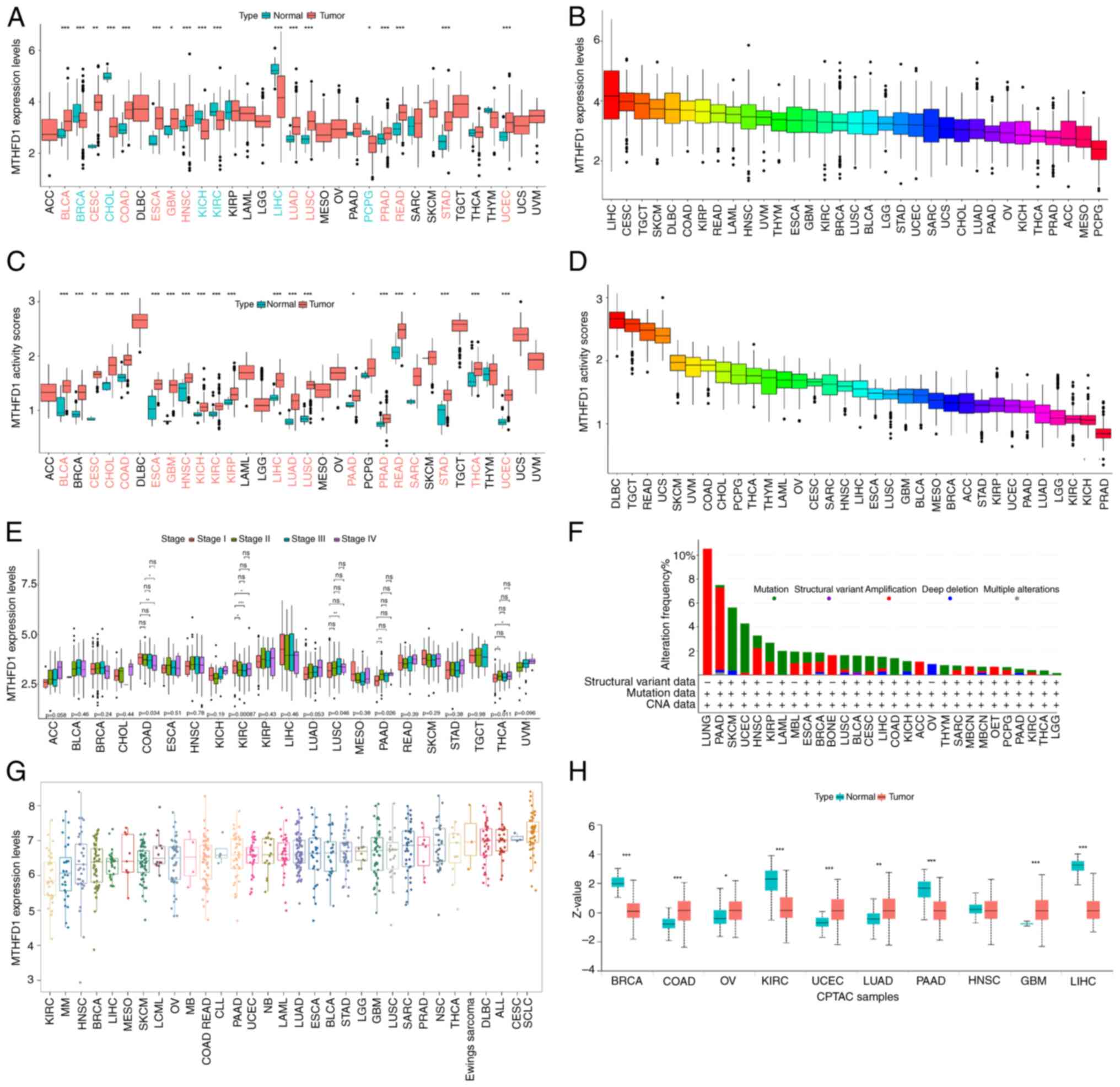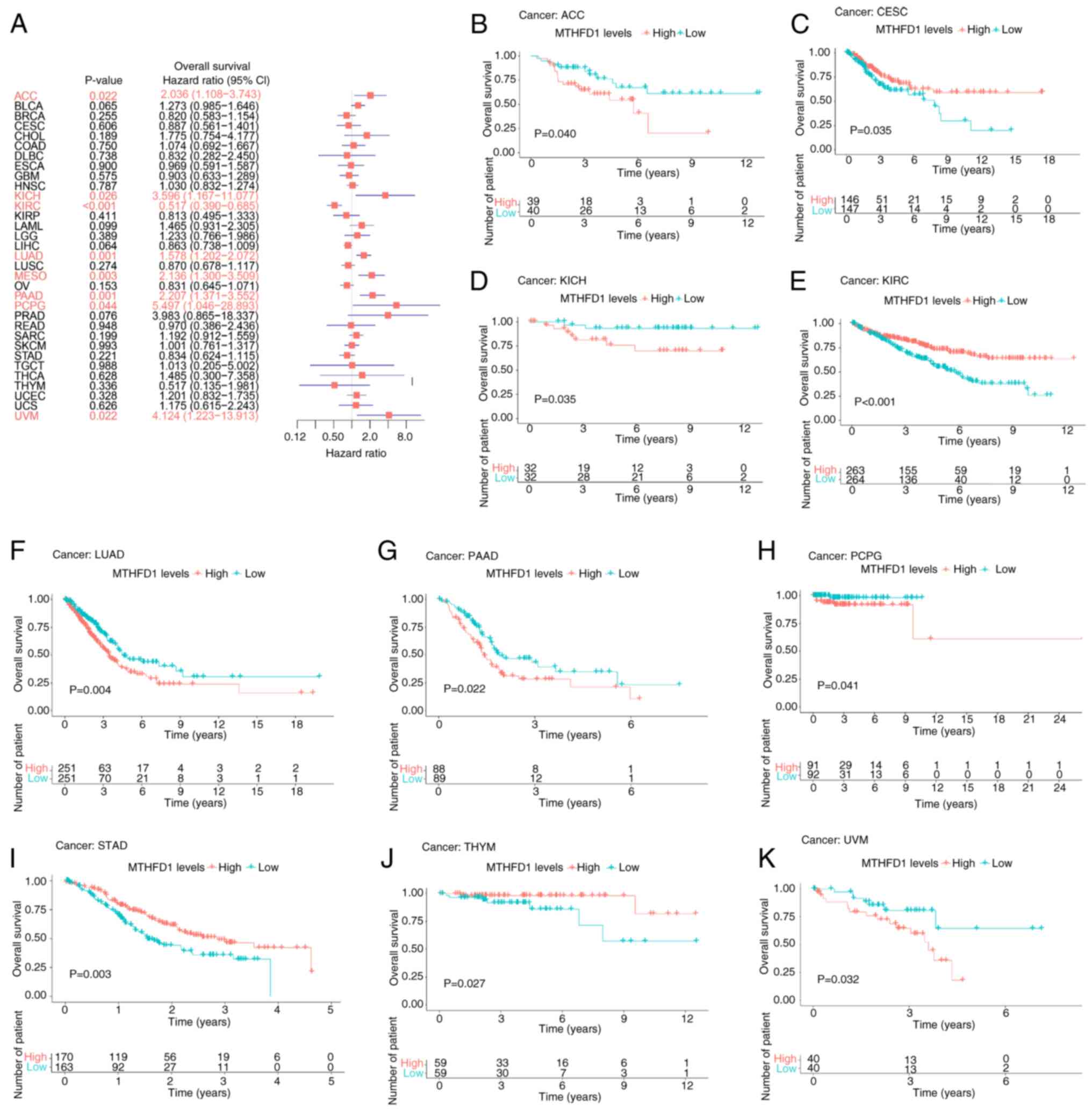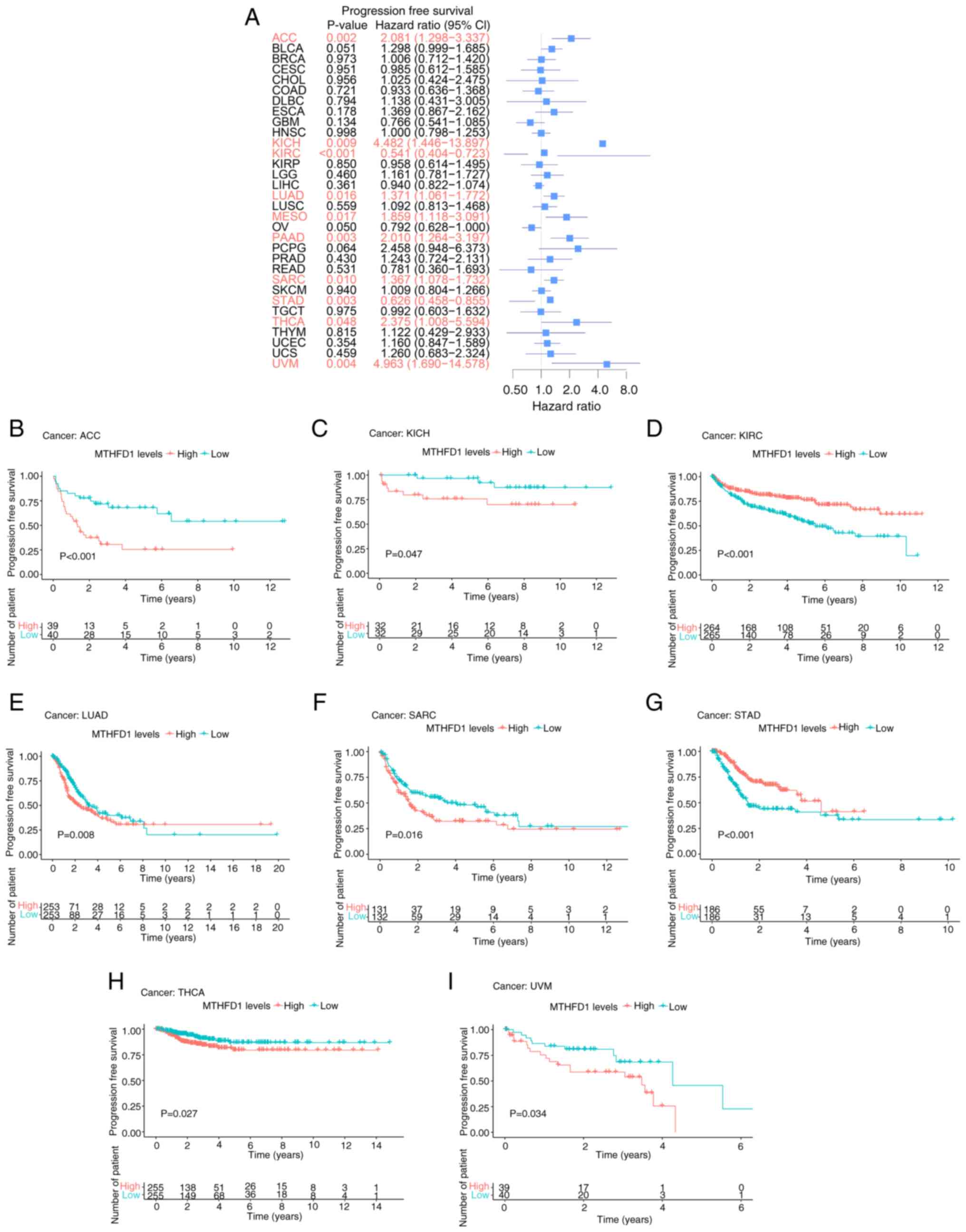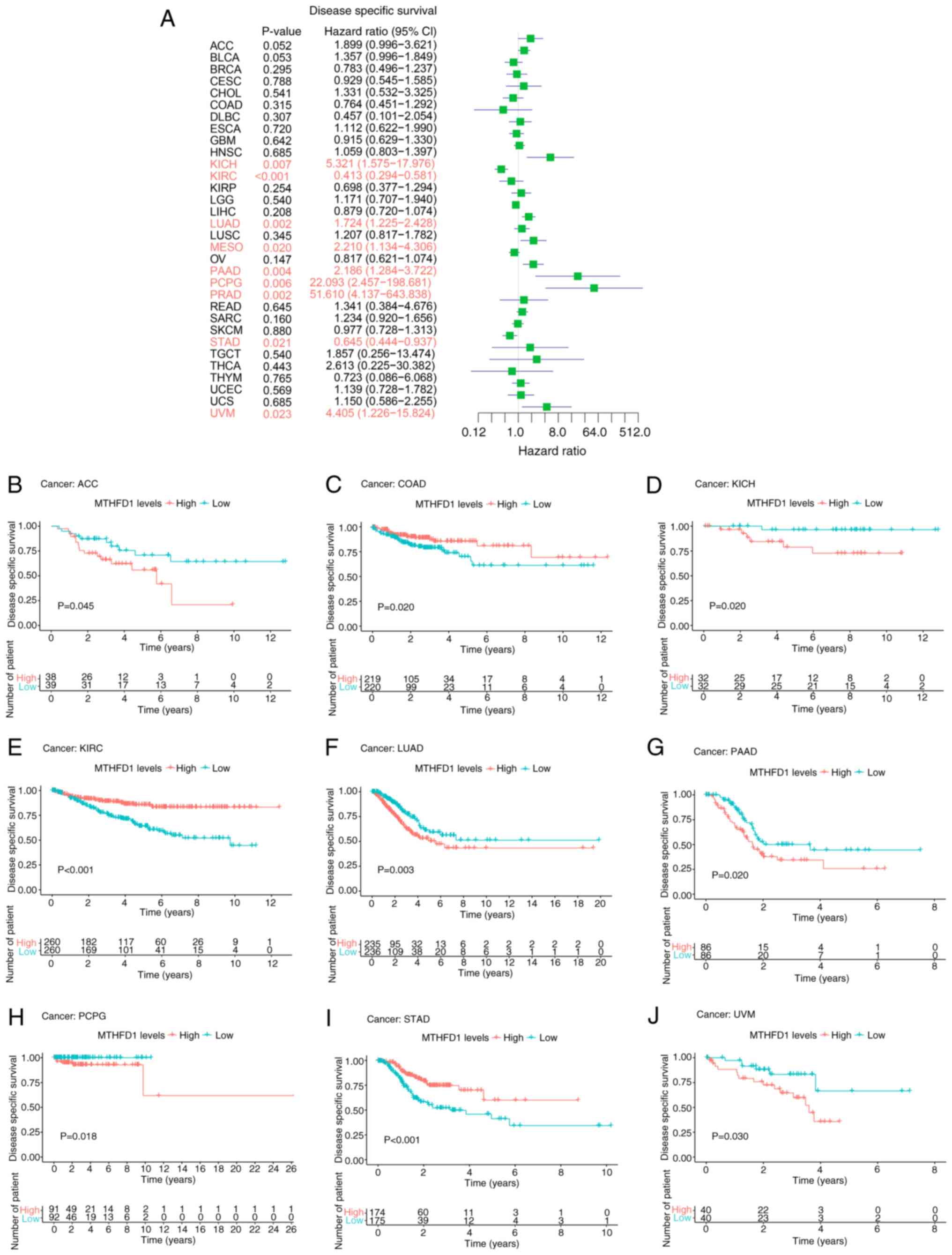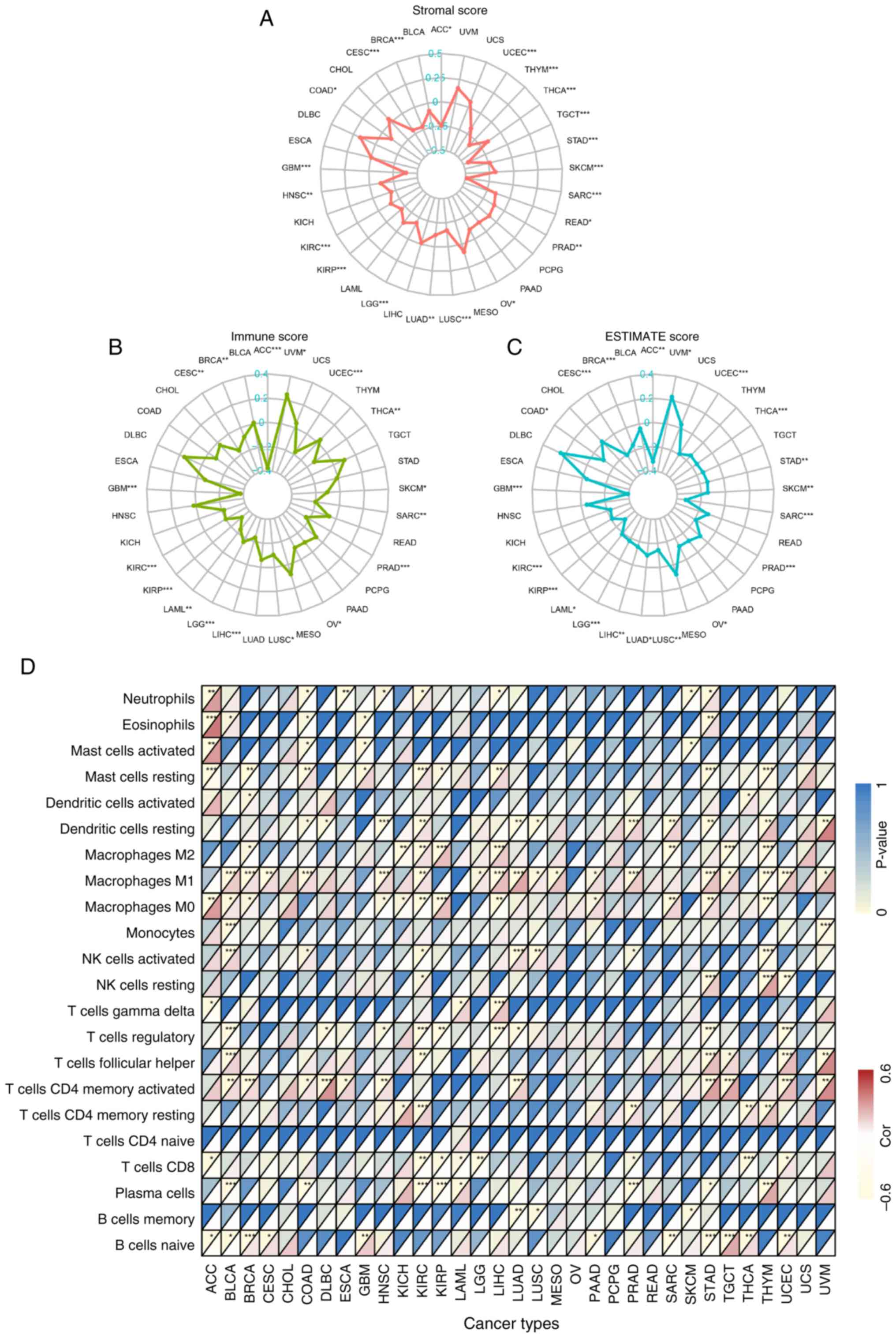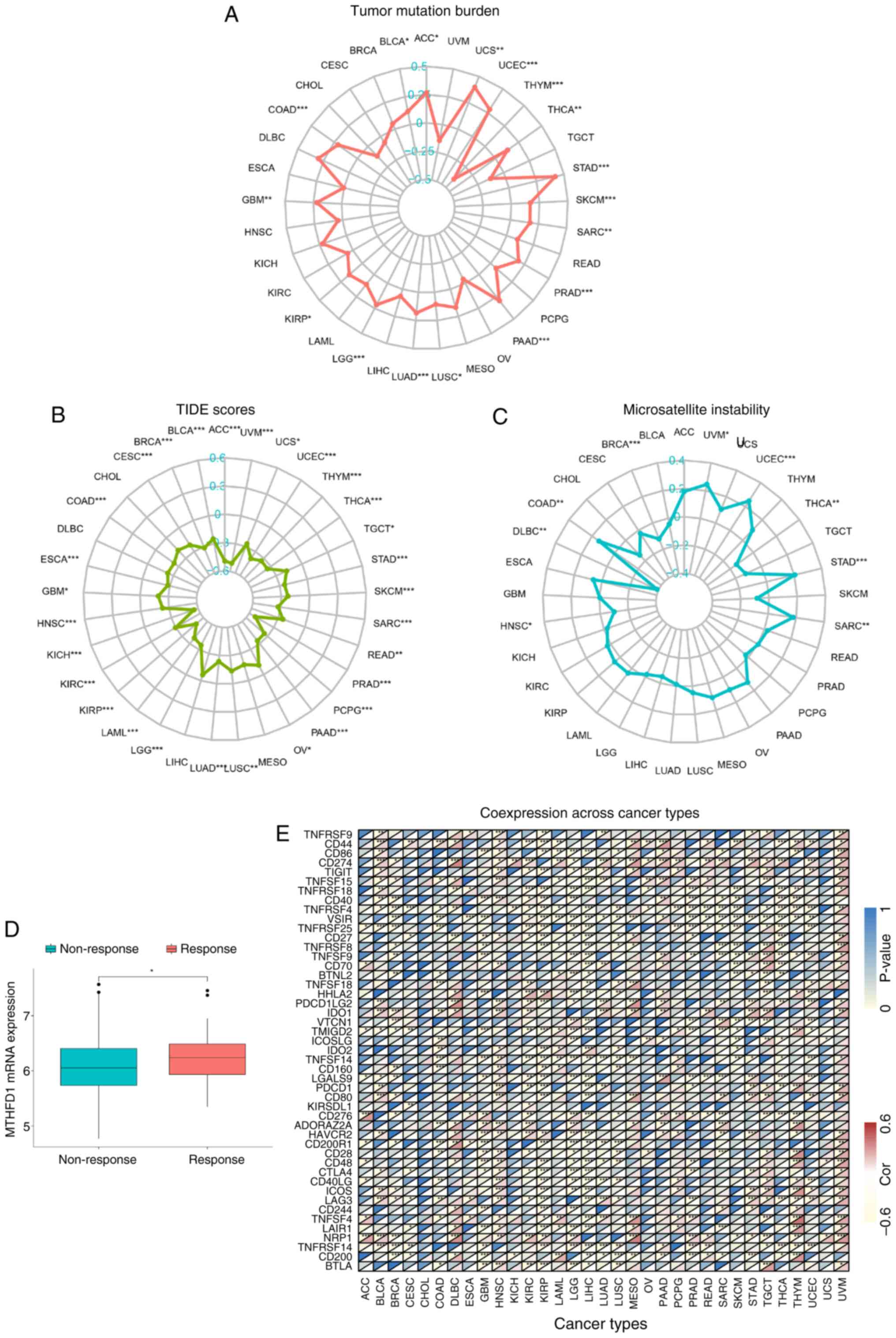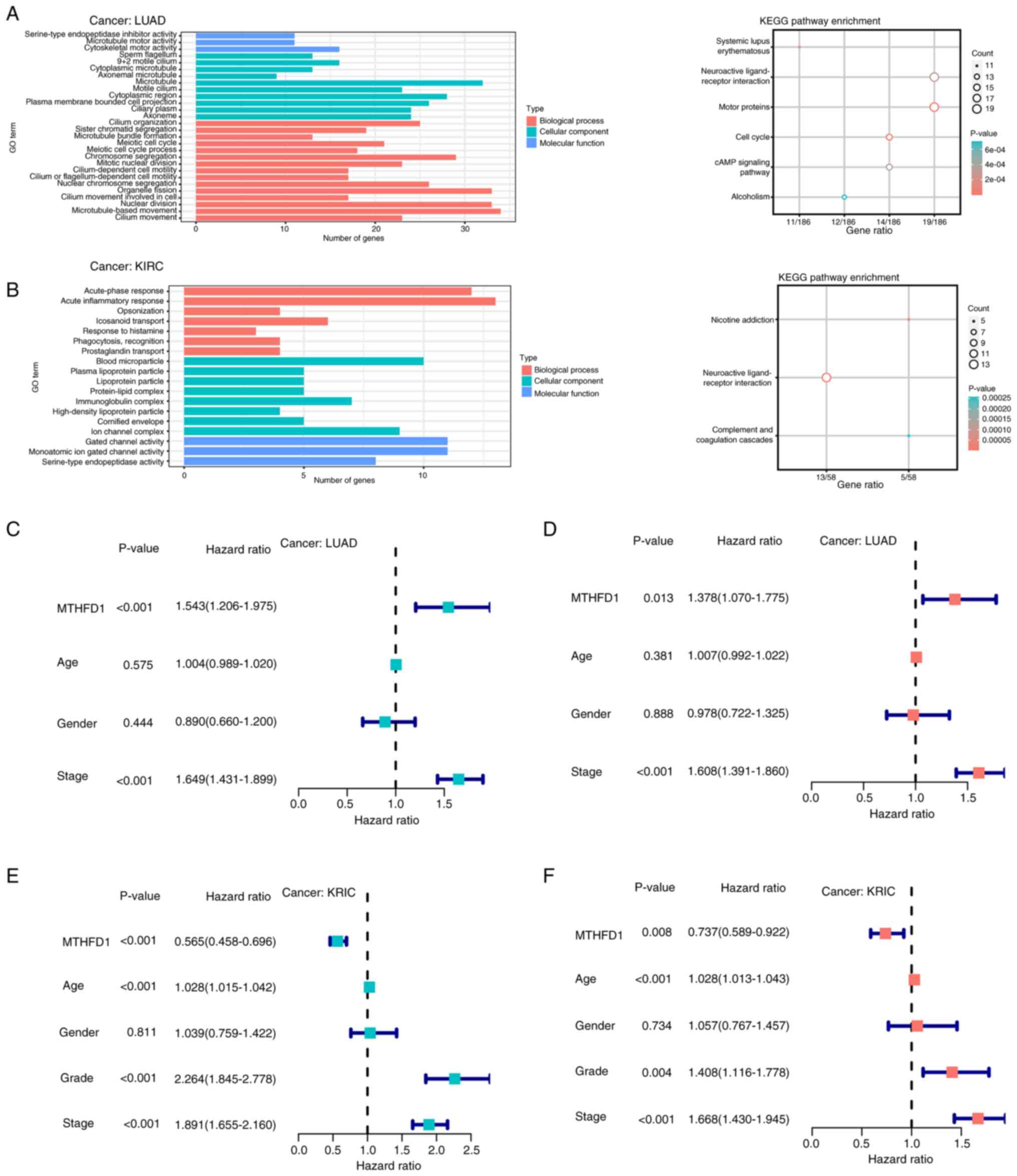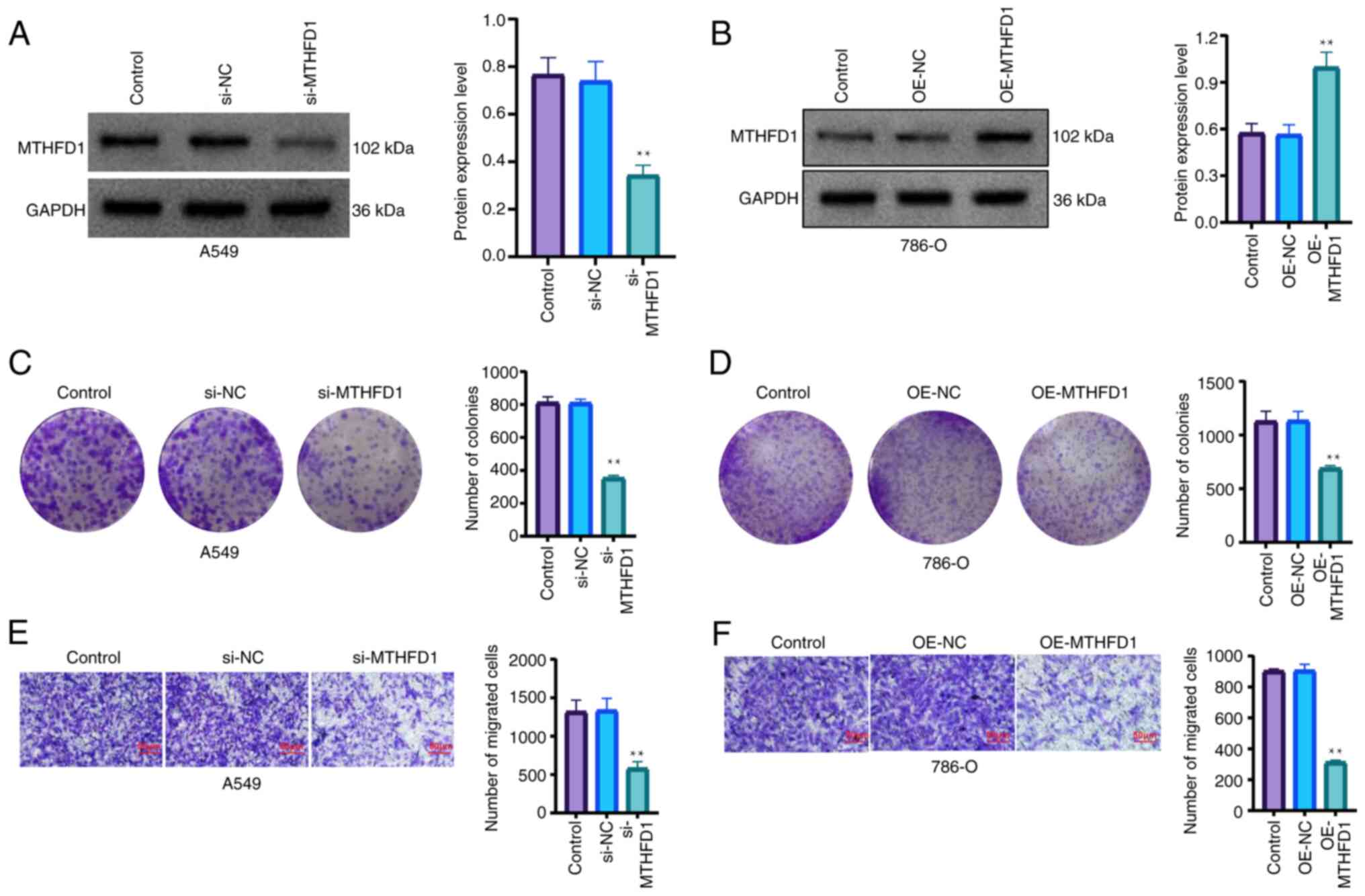|
1
|
Sung H, Ferlay J, Siegel RL, Laversanne M,
Soerjomataram I, Jemal A and Bray F: Global cancer statistics 2020:
GLOBOCAN estimates of incidence and mortality worldwide for 36
cancers in 185 countries. CA Cancer J Clin. 71:209–249.
2021.PubMed/NCBI View Article : Google Scholar
|
|
2
|
Zeng H, Chen W, Zheng R, Zhang S, Ji JS,
Zou X, Xia C, Sun K, Yang Z, Li H, et al: Changing cancer survival
in China during 2003-15: A pooled analysis of 17 population-based
cancer registries. Lancet Glob Heal. 6:e555–e567. 2018.PubMed/NCBI View Article : Google Scholar
|
|
3
|
Chang JH, Wu CC, Yuan KSP, Wu ATH and Wu
SY: Locoregionally recurrent head and neck squamous cell carcinoma:
Incidence, survival, prognostic factors, and treatment outcomes.
Oncotarget. 8:55600–55612. 2017.PubMed/NCBI View Article : Google Scholar
|
|
4
|
Nors J, Iversen LH, Erichsen R, Gotschalck
KA and Andersen CL: Incidence of recurrence and time to recurrence
in stage I to III colorectal cancer: A nationwide Danish cohort
study. JAMA Oncol. 10:54–62. 2024.PubMed/NCBI View Article : Google Scholar
|
|
5
|
Liu X, Ren B, Ren J, Gu M, You L and Zhao
Y: The significant role of amino acid metabolic reprogramming in
cancer. Cell Commun Signal. 22(380)2024.PubMed/NCBI View Article : Google Scholar
|
|
6
|
Zhang J, Chen M, Yang Y, Liu Z, Guo W,
Xiang P, Zeng Z, Wang D and Xiong W: Amino acid metabolic
reprogramming in the tumor microenvironment and its implication for
cancer therapy. J Cell Physiol. 239(e31349)2024.PubMed/NCBI View Article : Google Scholar
|
|
7
|
Liu Y, Zhao Y, Song H, Li Y, Liu Z, Ye Z,
Zhao J, Wu Y, Tang J and Yao M: Metabolic reprogramming in tumor
immune microenvironment: Impact on immune cell function and
therapeutic implications. Cancer Lett. 597(217076)2024.PubMed/NCBI View Article : Google Scholar
|
|
8
|
Liu Y, Zhao T, Li Z, Wang L, Yuan S and
Sun L: The role of ASCT2 in cancer: A review. Eur J Pharmacol.
837:81–87. 2018.PubMed/NCBI View Article : Google Scholar
|
|
9
|
Zhang Z, Liu R, Shuai Y, Huang Y, Jin R,
Wang X and Luo J: ASCT2 (SLC1A5)-dependent glutamine uptake is
involved in the progression of head and neck squamous cell
carcinoma. Br J Cancer. 122:82–93. 2020.PubMed/NCBI View Article : Google Scholar
|
|
10
|
Cormerais Y, Vučetić M, Parks SK and
Pouyssegur J: Amino acid transporters are a vital focal point in
the control of mTORC1 signaling and cancer. Int J Mol Sci.
22(23)2020.PubMed/NCBI View Article : Google Scholar
|
|
11
|
van Geldermalsen M, Wang Q, Nagarajah R,
Marshall AD, Thoeng A, Gao D, Ritchie W, Feng Y, Bailey CG, Deng N,
et al: ASCT2/SLC1A5 controls glutamine uptake and tumour growth in
triple-negative basal-like breast cancer. Oncogene. 35:3201–3208.
2016.PubMed/NCBI View Article : Google Scholar
|
|
12
|
Najumudeen AK, Ceteci F, Fey SK, Hamm G,
Steven RT, Hall H, Nikula CJ, Dexter A, Murta T, Race AM, et al:
The amino acid transporter SLC7A5 is required for efficient growth
of KRAS-mutant colorectal cancer. Nat Genet. 53:16–26.
2021.PubMed/NCBI View Article : Google Scholar
|
|
13
|
Ohgaki R, Hirase Y, Xu M, Okanishi H and
Kanai Y: LAT1 expression in colorectal cancer cells is unresponsive
to HIF-1/2α accumulation under experimental hypoxia. Sci Rep.
14(19635)2024.PubMed/NCBI View Article : Google Scholar
|
|
14
|
Hayase S, Kumamoto K, Saito K, Kofunato Y,
Sato Y, Okayama H, Miyamoto K, Ohki S and Takenoshita S: L-type
amino acid transporter 1 expression is upregulated and associated
with cellular proliferation in colorectal cancer. Oncol Lett.
14:7410–7416. 2017.PubMed/NCBI View Article : Google Scholar
|
|
15
|
Zhang Y, Xu Y, Lu W, Ghergurovich JM, Guo
L, Blair IA, Rabinowitz JD and Yang X: Upregulation of antioxidant
capacity and nucleotide precursor availability suffices for
oncogenic transformation. Cell Metab. 33:94–109.e8. 2021.PubMed/NCBI View Article : Google Scholar
|
|
16
|
Hu K, Li K, Lv J, Feng J, Chen J, Wu H,
Cheng F, Jiang W, Wang J, Pei H, et al: Suppression of the
SLC7A11/glutathione axis causes synthetic lethality in KRAS-mutant
lung adenocarcinoma. J Clin Invest. 130:1752–1766. 2020.PubMed/NCBI View Article : Google Scholar
|
|
17
|
Yang C, Chen J, Yu Z, Luo J, Li X, Zhou B
and Jiang N: Mining of RNA methylation-related genes and
elucidation of their molecular biology in gallbladder carcinoma.
Front Oncol. 11(621806)2021.PubMed/NCBI View Article : Google Scholar
|
|
18
|
Chen K, Wu S, Ye S, Huang H, Zhou Y, Zhou
H, Wu S, Mao Y, Shangguan F, Lan L and Chen B: Dimethyl fumarate
induces metabolic crisie to suppress pancreatic carcinoma. Front
Pharmacol. 12(617714)2021.PubMed/NCBI View Article : Google Scholar
|
|
19
|
Tarragó-Celada J, Foguet C,
Tarrado-Castellarnau M, Marin S, Hernández-Alias X, Perarnau J,
Morrish F, Hockenbery D, Gomis RR, Ruppin E, et al: Cysteine and
folate metabolism are targetable vulnerabilities of metastatic
colorectal cancer. Cancers (Basel). 13(425)2021.PubMed/NCBI View Article : Google Scholar
|
|
20
|
Ding K, Jiang J, Chen L and Xu X:
Methylenetetrahydrofolate dehydrogenase 1 silencing expedites the
apoptosis of non-small cell lung cancer cells via modulating DNA
methylation. Med Sci Monit. 24:7499–7507. 2018.PubMed/NCBI View Article : Google Scholar
|
|
21
|
Zheng Y, Zhu L, Qin ZY, Guo Y, Wang S, Xue
M, Shen KY, Hu BY, Wang XF, Wang CQ, et al: Modulation of cellular
metabolism by protein crotonylation regulates pancreatic cancer
progression. Cell Rep. 42(112666)2023.PubMed/NCBI View Article : Google Scholar
|
|
22
|
Pan S, Fan M, Liu Z, Li X and Wang H:
Serine, glycine and one-carbon metabolism in cancer (review). Int J
Oncol. 58:158–170. 2021.PubMed/NCBI View Article : Google Scholar
|
|
23
|
Fan J, Ye J, Kamphorst JJ, Shlomi T,
Thompson CB and Rabinowitz JD: Quantitative flux analysis reveals
folate-dependent NADPH production. Nature. 510:298–302.
2014.PubMed/NCBI View Article : Google Scholar
|
|
24
|
Lu SC and Mato JM: S-adenosylmethionine in
liver health, injury, and cancer. Physiol Rev. 92:1515–1542.
2012.PubMed/NCBI View Article : Google Scholar
|
|
25
|
MacFarlane AJ, Perry CA, Girnary HH, Gao
D, Allen RH, Stabler SP, Shane B and Stover PJ: Mthfd1 is an
essential gene in mice and alters biomarkers of impaired one-carbon
metabolism. J Biol Chem. 284:1533–1539. 2009.PubMed/NCBI View Article : Google Scholar
|
|
26
|
Lunt SY and Vander Heiden MG: Aerobic
glycolysis: Meeting the metabolic requirements of cell
proliferation. Annu Rev Cell Dev Biol. 27:441–464. 2011.PubMed/NCBI View Article : Google Scholar
|
|
27
|
Feitelson MA, Arzumanyan A, Kulathinal RJ,
Blain SW, Holcombe RF, Mahajna J, Marino M, Martinez-Chantar ML,
Nawroth R, Sanchez-Garcia I, et al: Sustained proliferation in
cancer: Mechanisms and novel therapeutic targets. Semin Cancer
Biol. 35 (Suppl 1):S25–S54. 2015.PubMed/NCBI View Article : Google Scholar
|
|
28
|
Mullen NJ and Singh PK: Nucleotide
metabolism: A pan-cancer metabolic dependency. Nat Rev Cancer.
23:275–294. 2023.PubMed/NCBI View Article : Google Scholar
|
|
29
|
Dong Y, Zhao H, Li H, Li X and Yang S: DNA
methylation as an early diagnostic marker of cancer (review).
Biomed Rep. 2:326–330. 2014.PubMed/NCBI View Article : Google Scholar
|
|
30
|
Dutta H and Jain N: Post-translational
modifications and their implications in cancer. Front Oncol.
13(1240115)2023.PubMed/NCBI View Article : Google Scholar
|
|
31
|
Becht E, Giraldo NA, Lacroix L, Buttard B,
Elarouci N, Petitprez F, Selves J, Laurent-Puig P, Sautès-Fridman
C, Fridman WH and de Reyniès A: Estimating the population abundance
of tissue-infiltrating immune and stromal cell populations using
gene expression. Genome Biol. 17(218)2016.PubMed/NCBI View Article : Google Scholar
|
|
32
|
Newman AM, Liu CL, Green MR, Gentles AJ,
Feng W, Xu Y, Hoang CD, Diehn M and Alizadeh AA: Robust enumeration
of cell subsets from tissue expression profiles. Nat Methods.
12:453–457. 2015.PubMed/NCBI View Article : Google Scholar
|
|
33
|
Hänzelmann S, Castelo R and Guinney J:
GSVA: Gene set variation analysis for microarray and RNA-seq data.
BMC Bioinformatics. 14(7)2013.PubMed/NCBI View Article : Google Scholar
|
|
34
|
Ritchie ME, Phipson B, Wu D, Hu Y, Law CW,
Shi W and Smyth GK: limma powers differential expression analyses
for RNA-sequencing and microarray studies. Nucleic Acids Res.
43(e47)2015.PubMed/NCBI View Article : Google Scholar
|
|
35
|
Wu T, Hu E, Xu S, Chen M, Guo P, Dai Z,
Feng T, Zhou L, Tang W, Zhan L, et al: clusterProfiler 4.0: A
universal enrichment tool for interpreting omics data. Innovation
(Camb). 2(100141)2021.PubMed/NCBI View Article : Google Scholar
|
|
36
|
Wang W, Gu W, Tang H, Mai Z, Xiao H, Zhao
J and Han J: The emerging role of MTHFD family genes in regulating
the tumor immunity of oral squamous cell carcinoma. J Oncol.
2022(4867730)2022.PubMed/NCBI View Article : Google Scholar
|
|
37
|
Cao J, Ding X, Ji J, Zhang L and Luo C:
Efficacy and safety of immune checkpoint inhibitors rechallenge in
advanced solid tumors: A systematic review and meta-analysis. Front
Oncol. 14(1475502)2024.PubMed/NCBI View Article : Google Scholar
|
|
38
|
Ma W, Xue R, Zhu Z, Farrukh H, Song W, Li
T, Zheng L and Pan CX: Increasing cure rates of solid tumors by
immune checkpoint inhibitors. Exp Hematol Oncol.
12(10)2023.PubMed/NCBI View Article : Google Scholar
|
|
39
|
Anagnostou V, Bardelli A, Chan TA and
Turajlic S: The status of tumor mutational burden and
immunotherapy. Nat Cancer. 3:652–656. 2022.PubMed/NCBI View Article : Google Scholar
|
|
40
|
Hong YD, Enewold L, Halpern MT, Zeruto C
and Mariotto AB: Use of pembrolizumab among older adults with
cancer in the United States, before and after FDA approval of its
tumor-agnostic indication. Pharmacoepidemiol Drug Saf.
33(e5745)2024.PubMed/NCBI View Article : Google Scholar
|
|
41
|
Li C, Xiao Y, Kong J, Lai C, Chen Z, Li Z
and Xie W: Elucidating the role of MICAL1 in pan-cancer using
integrated bioinformatics and experimental approaches. Cell Adh
Migr. 18:1–17. 2024.PubMed/NCBI View Article : Google Scholar
|
|
42
|
Cao W, Xie Y, Cai L, Wang M, Chen Z, Wang
Z, Xv J, Wang Y, Li R, Liu X and Wang W: Pan-cancer analysis on the
role of KMT2C expression in tumor progression and immunotherapy.
Oncol Lett. 28(444)2024.PubMed/NCBI View Article : Google Scholar
|
|
43
|
Zhang A, Miao K, Sun H and Deng CX: Tumor
heterogeneity reshapes the tumor microenvironment to influence drug
resistance. Int J Biol Sci. 18:3019–3033. 2022.PubMed/NCBI View Article : Google Scholar
|
|
44
|
Tzorakoleftheraki SE and Koletsa T: The
complex role of mast cells in head and neck squamous cell
carcinoma: A systematic review. Medicina (Kaunas).
60(1173)2024.PubMed/NCBI View Article : Google Scholar
|
|
45
|
Derakhshani A, Vahidian F, Alihasanzadeh
M, Mokhtarzadeh A, Lotfi Nezhad P and Baradaran B: Mast cells: A
double-edged sword in cancer. Immunol Lett. 209:28–35.
2019.PubMed/NCBI View Article : Google Scholar
|
|
46
|
Mocellin S, Marincola FM and Young HA:
Interleukin-10 and the immune response against cancer: A
counterpoint. J Leukoc Biol. 78:1043–1051. 2005.PubMed/NCBI View Article : Google Scholar
|
|
47
|
Ribatti D, Ennas MG, Vacca A, Ferreli F,
Nico B, Orru S and Sirigu P: Tumor vascularity and
tryptase-positive mast cells correlate with a poor prognosis in
melanoma. Eur J Clin Invest. 33:420–425. 2003.PubMed/NCBI View Article : Google Scholar
|
|
48
|
Watabe T, Takahashi K, Pietras K and
Yoshimatsu Y: Roles of TGF-β signals in tumor microenvironment via
regulation of the formation and plasticity of vascular system.
Semin Cancer Biol. 92:130–138. 2023.PubMed/NCBI View Article : Google Scholar
|
|
49
|
Chiba Y, Mizoguchi I, Furusawa J, Hasegawa
H, Ohashi M, Xu M, Owaki T and Yoshimoto T: Interleukin-27 exerts
its antitumor effects by promoting differentiation of hematopoietic
stem cells to M1 macrophages. Cancer Res. 78:182–194.
2018.PubMed/NCBI View Article : Google Scholar
|
|
50
|
Togashi Y, Shitara K and Nishikawa H:
Regulatory T cells in cancer immunosuppression-implications for
anticancer therapy. Nat Rev Clin Oncol. 16:356–371. 2019.PubMed/NCBI View Article : Google Scholar
|
|
51
|
Lin X, Kang K, Chen P, Zeng Z, Li G, Xiong
W, Yi M and Xiang B: Regulatory mechanisms of PD-1/PD-L1 in
cancers. Mol Cancer. 23(108)2024.PubMed/NCBI View Article : Google Scholar
|
|
52
|
Sabit H, Arneth B, Abdel-Ghany S, Madyan
EF, Ghaleb AH, Selvaraj P, Shin DM, Bommireddy R and Elhashash A:
Beyond cancer cells: How the tumor microenvironment drives cancer
progression. Cells. 13(1666)2024.PubMed/NCBI View Article : Google Scholar
|
|
53
|
Tie Y, Tang F, Wei YQ and Wei XW:
Immunosuppressive cells in cancer: Mechanisms and potential
therapeutic targets. J Hematol Oncol. 15(61)2022.PubMed/NCBI View Article : Google Scholar
|
|
54
|
Jechorek D, Haeusler-Pliske I, Meyer F and
Roessner A: Diagnostic value of syndecan-4 protein expression in
colorectal cancer. Pathol Res Pract. 222(153431)2021.PubMed/NCBI View Article : Google Scholar
|
|
55
|
Zeng Y, Luo Y, Zhao K, Liu S, Wu K, Wu Y,
Du K, Pan W, Dai Y, Liu Y, et al: m6A-mediated induction of
7-dehydrocholesterol reductase stimulates cholesterol synthesis and
cAMP signaling to promote bladder cancer metastasis. Cancer Res.
84:3402–3418. 2024.PubMed/NCBI View Article : Google Scholar
|
|
56
|
Palumbo JS and Degen JL: Mechanisms
linking tumor cell-associated procoagulant function to tumor
metastasis. Thromb Res. 120 (Suppl 2):S22–S28. 2007.PubMed/NCBI View Article : Google Scholar
|
|
57
|
Ricklin D, Hajishengallis G, Yang K and
Lambris JD: Complement: A key system for immune surveillance and
homeostasis. Nat Immunol. 11:785–797. 2010.PubMed/NCBI View Article : Google Scholar
|
|
58
|
Monteith GR, McAndrew D, Faddy HM and
Roberts-Thomson SJ: Calcium and cancer: Targeting Ca2+ transport.
Nat Rev Cancer. 7:519–530. 2007.PubMed/NCBI View Article : Google Scholar
|
|
59
|
Zhao H, Wu L, Yan G, Chen Y, Zhou M, Wu Y
and Li Y: Inflammation and tumor progression: Signaling pathways
and targeted intervention. Signal Transduct Target Ther.
6(263)2021.PubMed/NCBI View Article : Google Scholar
|
|
60
|
Ahrberg Y, Dallmann J, Freitag J, Hassan
A, Jung C, Kiefer J, Muralidharan AM, Peter M and Beck JD: CIMT
2024: Report on the 21st annual meeting of the association for
cancer immunotherapy. Hum Vaccin Immunother.
20(2381925)2024.PubMed/NCBI View Article : Google Scholar
|
|
61
|
Jiang P, Gu S, Pan D, Fu J, Sahu A, Hu X,
Li Z, Traugh N, Bu X, Li B, et al: Signatures of T cell dysfunction
and exclusion predict cancer immunotherapy response. Nat Med.
24:1550–1558. 2018.PubMed/NCBI View Article : Google Scholar
|
|
62
|
Kang K, Xie F, Wu Y, Han C, Bai Y, Long J,
Lian X and Zhang F: Genomic instability in lower-grade glioma:
Prediction of prognosis based on lncRNA and immune infiltration.
Mol Ther Oncolytics. 22:431–443. 2021.PubMed/NCBI View Article : Google Scholar
|
|
63
|
Han H, Su H, Lv Z, Zhu C and Huang J:
Identifying MTHFD1 and LGALS4 as potential therapeutic targets in
prostate cancer through multi-omics mendelian randomization
analysis. Biomedicines. 13(185)2025.PubMed/NCBI View Article : Google Scholar
|
|
64
|
Hui Y, Leng J, Jin D, Wang G, Liu K, Bu Y
and Wang Q: BRG1 promotes liver cancer cell proliferation and
metastasis by enhancing mitochondrial function and ATP5A1 synthesis
through TOMM40. Cancer Biol Ther. 25(2375440)2024.PubMed/NCBI View Article : Google Scholar
|
|
65
|
Tadic S and Martínez A: Nucleic acid
cancer vaccines targeting tumor related angiogenesis. Could mRNA
vaccines constitute a game changer? Front Immunol.
15(1433185)2024.PubMed/NCBI View Article : Google Scholar
|
|
66
|
Kubota Y, Han Q, Aoki Y, Masaki N, Obara
K, Hamada K, Hozumi C, Wong ACW, Bouvet M, Tsunoda T and Hoffman
RM: Synergy of combining methionine restriction and chemotherapy:
The disruptive next generation of cancer treatment. Cancer Diagn
Progn. 3:272–281. 2023.PubMed/NCBI View Article : Google Scholar
|
|
67
|
Qiu Y, Xie E, Xu H, Cheng H and Li G:
One-carbon metabolism shapes T cell immunity in cancer. Trends
Endocrinol Metab. 35:967–980. 2024.PubMed/NCBI View Article : Google Scholar
|
|
68
|
Pereira JA, Lanzar Z, Clark JT, Hart AP,
Douglas BB, Shallberg L, O'Dea K, Christian DA and Hunter CA: PD-1
and CTLA-4 exert additive control of effector regulatory T cells at
homeostasis. Front Immunol. 14(997376)2023.PubMed/NCBI View Article : Google Scholar
|
|
69
|
Xiao B, Li G, Gulizeba H, Liu H, Sima X,
Zhou T and Huang Y: Choline metabolism reprogramming mediates an
immunosuppressive microenvironment in non-small cell lung cancer
(NSCLC) by promoting tumor-associated macrophage functional
polarization and endothelial cell proliferation. J Transl Med.
22(442)2024.PubMed/NCBI View Article : Google Scholar
|
|
70
|
Li Z, Ke H, Cai J, Ye S, Huang J, Zhang C,
Yuan M, Lan P and Wu X: MTHFD1 regulates autophagy to promote
growth and metastasis in colorectal cancer via the PI3K-AKT-mTOR
signaling pathway. Cancer Med. 13(e70267)2024.PubMed/NCBI View Article : Google Scholar
|
|
71
|
Zhang X and Wang Z: Targeting SHMTs and
MTHFDs in cancer: Attractive opportunity for anti-tumor strategy.
Front Pharmacol. 15(1335785)2024.PubMed/NCBI View Article : Google Scholar
|
|
72
|
Groth M, Moissiard G, Wirtz M, Wang H,
Garcia-Salinas C, Ramos-Parra PA, Bischof S, Feng S, Cokus SJ, John
A, et al: MTHFD1 controls DNA methylation in Arabidopsis. Nat
Commun. 7(11640)2016.PubMed/NCBI View Article : Google Scholar
|
|
73
|
Manjili MH and Butler SE: Role of tregs in
cancer dormancy or recurrence. Immunol Invest. 45:759–766.
2016.PubMed/NCBI View Article : Google Scholar
|
|
74
|
Hoffmann F, Franzen A, de Vos L, Wuest L,
Kulcsár Z, Fietz S, Maas AP, Hollick S, Diop MY, Gabrielpillai J,
et al: CTLA4 DNA methylation is associated with CTLA-4 expression
and predicts response to immunotherapy in head and neck squamous
cell carcinoma. Clin Epigenetics. 15(112)2023.PubMed/NCBI View Article : Google Scholar
|
|
75
|
Grant CE, Flis AL, Toulabi L, Zingone A,
Rossi E, Aploks K, Sheppard H and Ryan BM: DRD1 suppresses cell
proliferation and reduces EGFR activation and PD-L1 expression in
NSCLC. Mol Oncol. 18:1631–1648. 2024.PubMed/NCBI View Article : Google Scholar
|
















